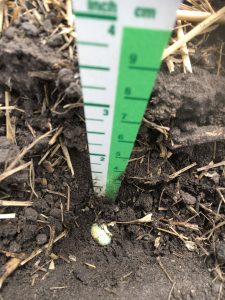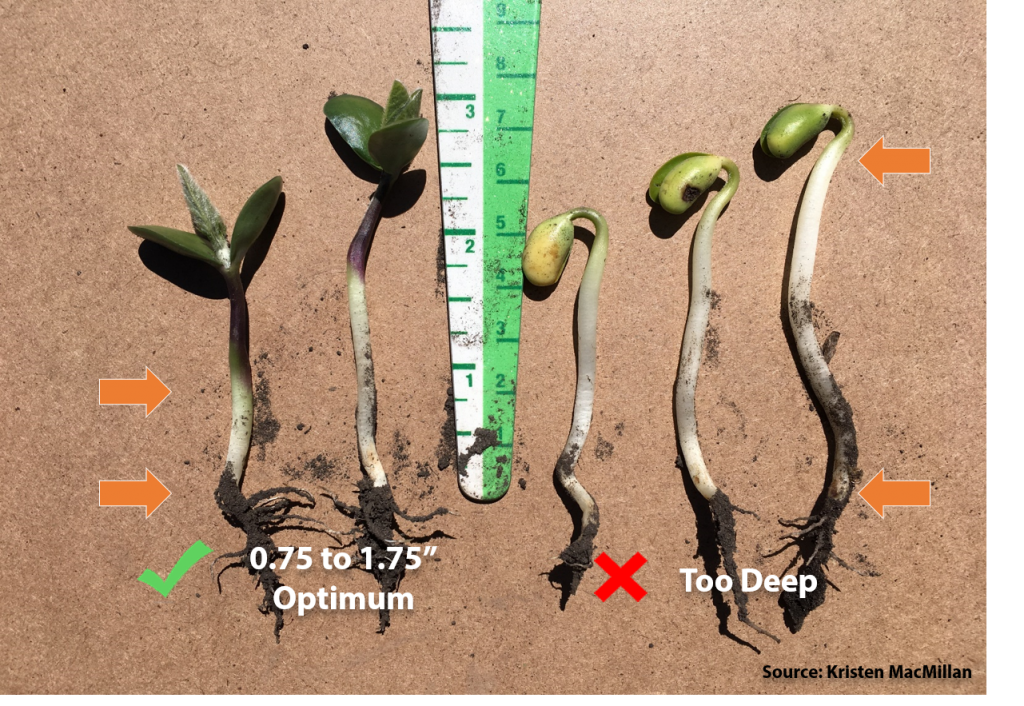Recommended Seed Depth
The optimal seed depth range for soybeans in Manitoba is 0.75–1.75 inches, no shallower and no deeper, for the best emergence and yield potential. This is based on the latest research from the MPSG-funded Soybean and Pulse Agronomy Lab led by Kristen P. MacMillan at the University of Manitoba.
To determine the appropriate depth to target within this range in a given year, consider soil moisture, residue management, land rolling, water holding capacity of soil, compaction risk and the rain forecast. Ensure good seed contact with soil moisture, if possible, and avoid planting deeper than 1.75 inches.
In dry seedbeds, the decision often comes down to dusting in the seed and hoping for rain, or planting deeper into soil moisture. If you choose the hope-for-rain approach and seed is placed in dry soil, your seed will need a really good rain to properly germinate and take off. If seeds germinate and do not receive adequate moisture afterward, they can desiccate and die off. Alternatively, deep planting (>1.75 inches) poses the risk of seedling stress, including slower or patchy emergence, swollen hypocotyls, yellow cotyledons or loss of cotyledons, resulting in yield loss.
How to Assess Seed Depth
- Check seed depth a few times while seeding. It’s best to check when you first start seeding, then again later on in different parts of the field. This is to ensure your equipment is functioning properly, ensure uniform depth and to account for any seedbed variability across the field.
- Dig for seed carefully using a good digging tool (one that is small, sturdy and has a ruler). Scrape away soil within the furrow to uncover seed or underground seedlings. Measure the distance from the seed to the top of the true soil surface. This does not always equate to the top of the furrow. Check different furrows along the seeder, noting whether you are in a wheel track or not.
- Post-emergent seed depth assessment can be done by measuring the length of white space along the hypocotyl from the root hairs to the green tissue.
- Does your equipment influence seed depth? If your seeder has openers that dig a deep furrow and create bigger hills, and/or if you have wide packing wheels that push more soil over the furrow, your seed may end up deeper than intended. Land rolling may increase the effective seed depth by closing furrows, and equipment often has a 0.5-inch variation in seed depth among openers or wings. Check seed depth after rolling to measure this in your fields.
- Symptoms of deep seeding may include a swollen hypocotyl, elongated hypocotyl arch, yellow cotyledons above or below ground and/or loss of cotyledons. Deep seeding is considered to be >1.75 inches, according to the most recent research from the Soybean and Pulse Agronomy Lab in Manitoba.
- Symptoms of shallow seeding include seed stranding, where seeds did not make it into the furrow, desiccated seeds within the furrow that partially germinated, then ran out of moisture or reduced plant stand, in the case of emerged seedlings.
Research Results in Manitoba
In a study conducted by the Soybean and Pulse Agronomy Lab, soybean seed depths of 0.25, 0.5, 0.75, 1.0, 1.25, 1.50, 1.75 and 2.25 inches were tested at Arborg (clay soil) and Carman (loam soil) from 2017 to 2019. The objective of the study was to identify the optimum seeding depth for soybeans in Manitoba. Dry soil conditions have often led agronomists and farmers to chase moisture and seed soybeans at >2 inches. However, information has been limited on the yield impacts of both deep and shallow seeding in the province.
Trials were seeded between May 14 to 24 into dry soil conditions at a seeding rate of 200,000 seeds/ac. Growing season conditions at all environments were drier than normal with cumulative spring precipitation in May and June equating to 56-145mm (40-87% of normal). At the time of seeding, moist soil was down to 1.25 inches at both locations in 2018 and an accumulated 25 mm of rain occurred between 10 and 22 days after seeding among all environments.
Plant Density
Soybean seed depths ranging from 0.5 to 2.25 inches resulted in maximum plant density (Figure 1), achieve the recommended target plant stands of 140-160,000 live plants/ac. Very shallow seeding (0.25 inches) resulted in significantly lower plant density (Figure 1) – 81,000 plants/ac, on average (equal to 41% establishment), which is only about 50% of a recommended plant stand. Deep seeding (2.25 inches) resulted in 143,000 plants/ac, on average (equal to 71% establishment), and was similar to the seed depth range of 0.5-1.75 inches. Delayed and/or reduced plant establishment and reduced seedling vigour were associated with non-optimal seed depth. Shallow seeding (0.25 inches) was prone to moisture fluctuations at the soil surface, resulting in lower germination and establishment (Figure 1). Deep seeding (2.25 inches) resulted in greater establishment but emergence was delayed, increasing the risk of soil pathogens and pests. Seedlings also showed hypocotyl swelling, loss of cotyledons and chlorosis during emergence. The loss of one cotyledon has little effect on growth, but loss of both cotyledons at the VE stage has been shown to reduce yield by 8-9% (Hanway and Thompson, 1967).
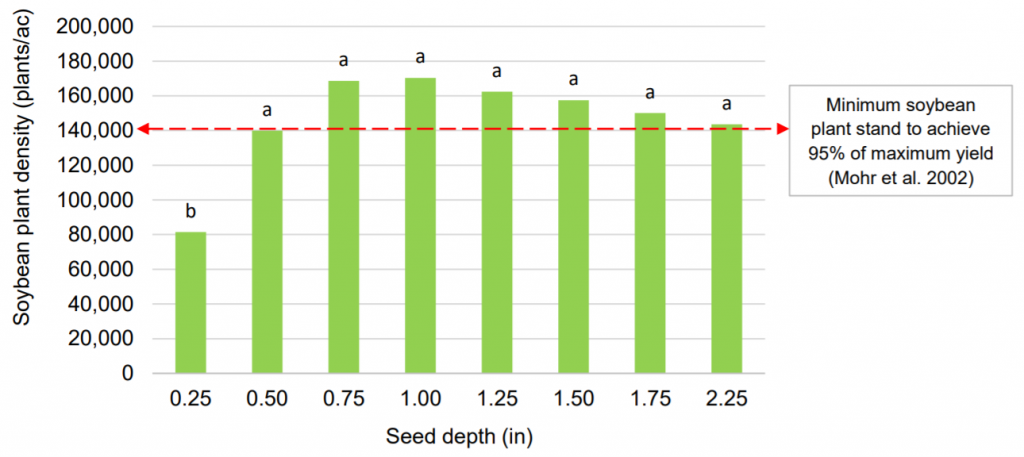
Yield
Soybean yields ranged from 21 to 29 bu/ac across all environments. Although these yields are below the 10 yr provincial average of 34 bu/ac (MASC 2020), they are reflective of the growing seasons which received only 42 to 77% of normal precipitation from May through August.
The seed depth range that maximized soybean yield (91-100% of maximum yield) was between 0.75 and 1.75 inches with yield maximization at 1.25 inches. This study provides evidence that even under dry soil conditions, there is no benefit to chasing moisture and seeding soybeans deeper than the recommended range. Farmers and agronomists should choose seed depths within the range of 0.75 and 1.75 inches, depending on soil type, soil moisture, management practices and equipment. Measuring seed depth during seeding and making adjustments by field is important. A post-emergent assessment to measure actual seeding depth at the cotyledon stage should be adopted to ensure that the target seed depth was achieved.
Compared to other soybean management decisions studied by the soybean and pulse agronomy program, including seeding date, fungicide and variety choice, ensuring seed depth is within the optimum range is likely the most influential to soybean yield, on average. In this study, shallow (0.25-inch) and deep (2.25-inch) seeding reduced soybean yield on average by 19 and 10%, respectively, and ranged from 0-36%. Shallow seeding was more detrimental than deep seeding in this study, likely due to dry soil conditions. Mechanisms of yield loss with non-optimal seed depth observed in this study include delayed and reduced plant establishment, hypocotyl swelling, loss of cotyledon(s) and reduced seedling vigour.
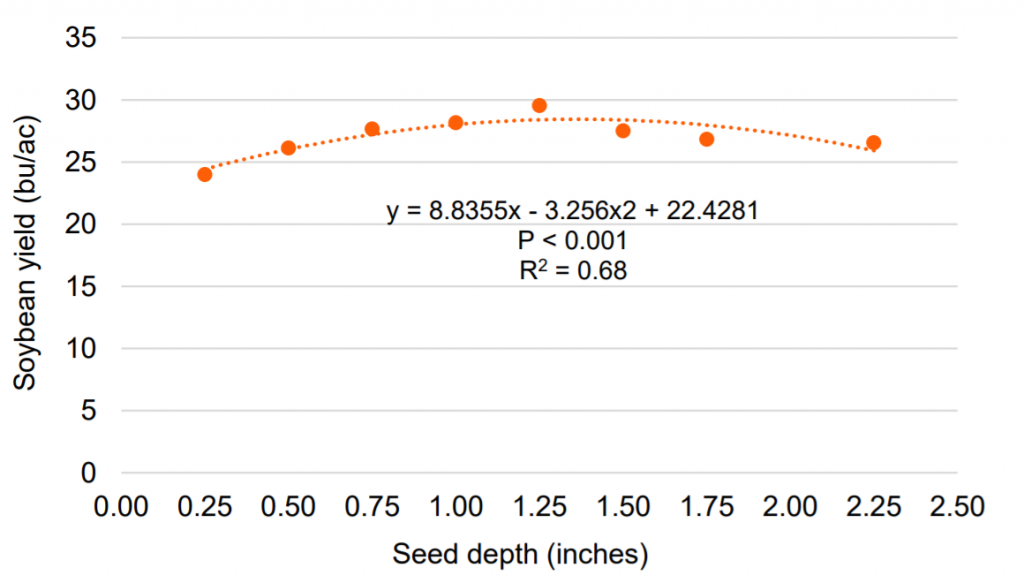
Pod Height
Does seed depth affect pod height? The height of the first pod bearing node was also measured in this study. Pod height was significantly affected by seed depth and environment, but the agronomic differences are far more important for the effect of environment than seed depth. Among seed depths, pod height ranged from 3.5 to 3.9 inches and was statistically similar for all seed depths from 0.5 to 2.25 inches, only being significantly reduced by very shallow seeding (0.25 inches) (Figure 3). Among environments, however, pod height ranged from 3.1 to 4.7 inches, which is a 1.5-fold difference. Environmental conditions and genetics are known to influence pod height while management practices have been shown to have little to no impact (Tkachuk, 2019). The lowest pod height was observed at Arborg in 2019, which was also the environment with coolest and driest spring growing conditions.
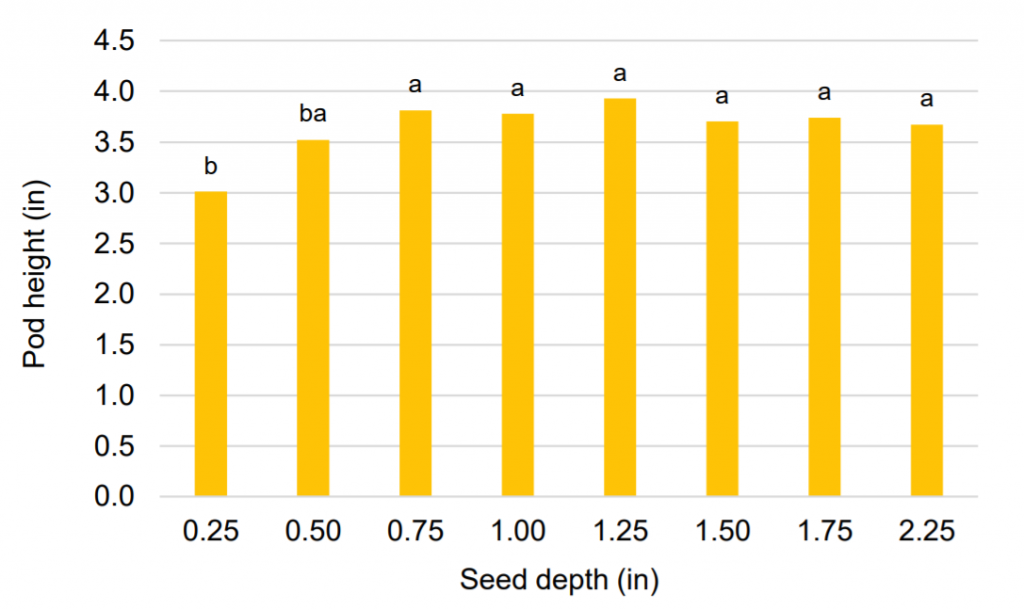
Information was adapted from the Soybean and Pulse Agronomy Lab 2019 and 2020 Annual Report. Refer to this report for more details from this study.

